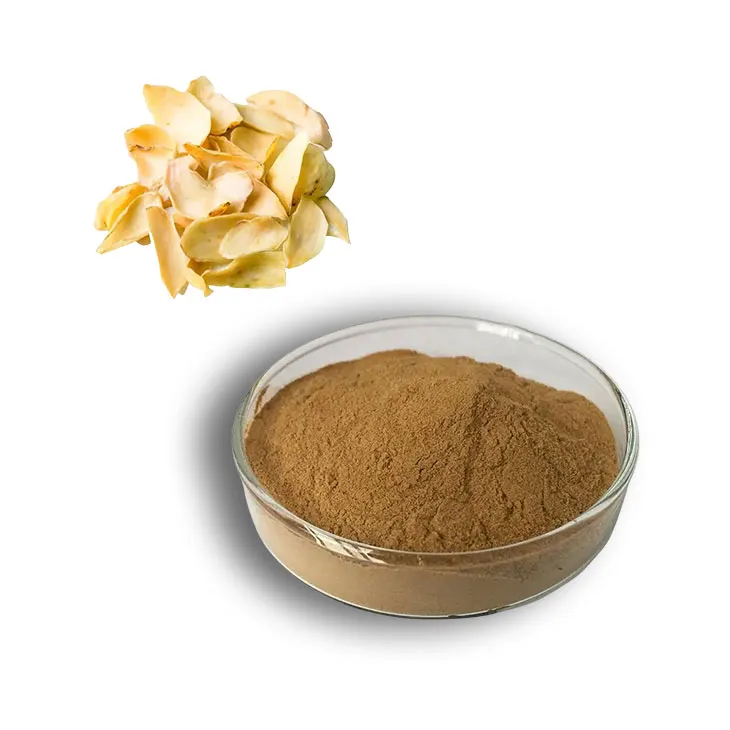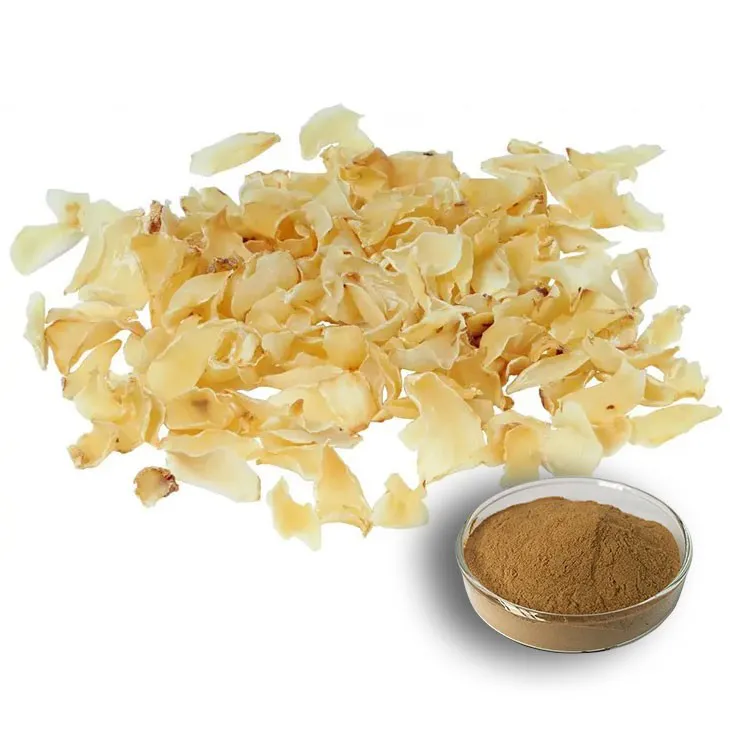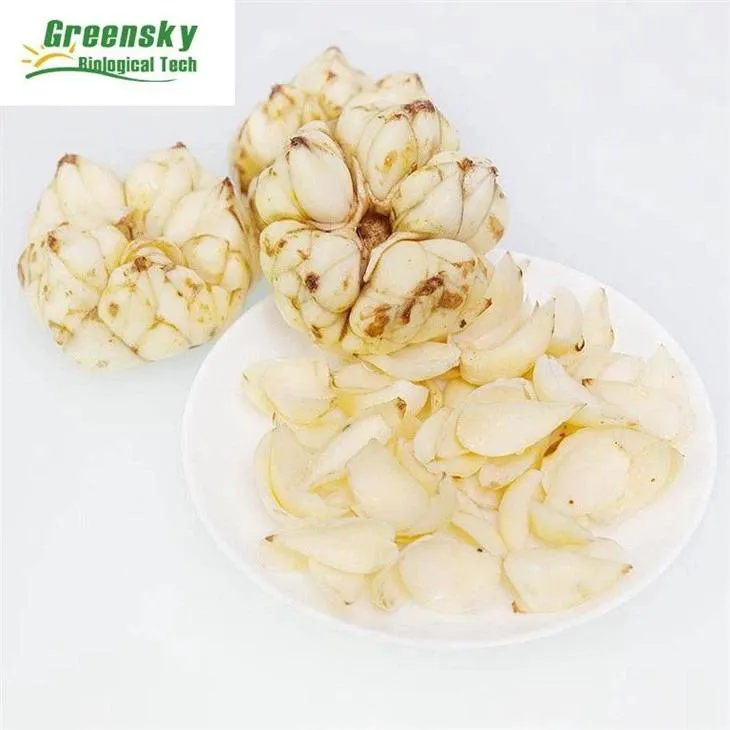- 0086-571-85302990
- sales@greenskybio.com
Lily Extract: From Leaves to Extraction.
2024-11-13

1. Introduction
The world of botanical extracts is rich and diverse, and Lily extract stands out as a particularly interesting and valuable substance. Lilies are known for their beauty and elegance, but their significance extends far beyond the ornamental realm. The journey from lily leaves to Lily extract is a complex and multi - faceted process that involves understanding the unique characteristics of the lily leaves and applying advanced extraction techniques.

2. The Unique Properties of Lily Leaves
2.1. Chemical Composition
Lily leaves possess a unique chemical composition that makes them an excellent source for extraction. They contain a variety of bioactive compounds such as flavonoids, alkaloids, and phenolic acids. Flavonoids, for example, are known for their antioxidant properties. These compounds play a crucial role in protecting the plant from environmental stressors such as UV radiation and pathogen attacks. In the context of extraction, these bioactive compounds are the valuable components that we aim to isolate and utilize.
2.2. Physical Characteristics
The physical characteristics of lily leaves also contribute to their suitability for extraction. Lily leaves are typically thin and have a large surface - to - volume ratio. This allows for efficient extraction as solvents can easily penetrate the leaf tissue. Moreover, the texture of the leaves is such that they can be easily processed without excessive mechanical damage, which could potentially lead to the loss of valuable components.

3. The Importance of Lily extract
3.1. In the Cosmetic Industry
Lily extract has found wide applications in the cosmetic industry. Its antioxidant properties, mainly due to the presence of flavonoids, make it an ideal ingredient for anti - aging products. It helps in reducing the appearance of wrinkles and fine lines by neutralizing free radicals that damage the skin cells. Additionally, lily extract has moisturizing properties, which can improve the skin's hydration levels, leaving it soft and supple.
3.2. In the Pharmaceutical Field
In the pharmaceutical field, lily extract shows great potential. Some of the bioactive compounds present in lily leaves have been studied for their anti - inflammatory and antimicrobial properties. For example, certain alkaloids in lily extract may have the ability to inhibit the growth of harmful bacteria and fungi. This makes it a possible candidate for the development of new drugs or as a complementary therapy in treating various infections and inflammatory diseases.
3.3. In the Food and Beverage Sector
The food and beverage sector has also started to explore the use of lily extract. Its unique flavor profile, which is slightly sweet and floral, can be used to enhance the taste of certain products. Moreover, given its antioxidant properties, it can also act as a natural preservative, extending the shelf - life of food items. For example, in some herbal teas or natural fruit juices, lily extract can be added to provide both flavor and health benefits.

4. Extraction Techniques
4.1. Solvent Extraction
Solvent extraction is one of the most commonly used methods for obtaining lily extract from the leaves. A suitable solvent, such as ethanol or methanol, is chosen based on the solubility of the target compounds. The process involves soaking the lily leaves in the solvent for a specific period of time. This allows the bioactive compounds to dissolve into the solvent.
- Advantages: It is a relatively simple and cost - effective method. It can extract a wide range of compounds depending on the solvent used.
- Disadvantages: There is a risk of solvent residues remaining in the final extract, which may require additional purification steps. Also, some heat - sensitive compounds may be degraded during the extraction process if not carefully controlled.
4.2. Supercritical Fluid Extraction
Supercritical fluid extraction (SFE) is an advanced technique that has gained popularity in recent years. In this method, a supercritical fluid, typically carbon dioxide (CO₂), is used as the extraction solvent. The supercritical state of CO₂ has properties that are intermediate between a gas and a liquid, allowing for efficient extraction.
- Advantages: It is a clean and environmentally friendly method as CO₂ is non - toxic and easily removable from the final extract. It can operate at relatively low temperatures, which is beneficial for the extraction of heat - sensitive compounds.
- Disadvantages: The equipment required for SFE is relatively expensive, which may limit its widespread use in some small - scale operations.
4.3. Microwave - Assisted Extraction
Microwave - assisted extraction (MAE) utilizes microwave energy to accelerate the extraction process. The microwaves cause the molecules in the lily leaves and the solvent to vibrate rapidly, increasing the mass transfer rate of the bioactive compounds into the solvent.
- Advantages: It significantly reduces the extraction time compared to traditional methods. It can also improve the extraction efficiency of certain compounds.
- Disadvantages: There is a need to carefully control the microwave power and extraction time to avoid over - extraction or degradation of the compounds.

5. Preserving the Beneficial Components during Extraction
5.1. Optimization of Extraction Parameters
To preserve the beneficial components of lily during extraction, it is crucial to optimize the extraction parameters. This includes factors such as temperature, extraction time, and solvent - to - sample ratio. For example, in solvent extraction, a lower temperature may be preferred for heat - sensitive compounds. By carefully adjusting these parameters, we can maximize the extraction of the desired compounds while minimizing their degradation.
5.2. Use of Protective Agents
Another approach is to use protective agents during extraction. These can be substances that prevent the oxidation or degradation of the bioactive compounds. For instance, adding antioxidants such as vitamin C or E during the extraction process can help protect the flavonoids and other sensitive components in lily leaves from oxidative damage.
6. Quality Control of Lily Extract
6.1. Analytical Methods
Quality control of lily extract is essential to ensure its safety and efficacy. Analytical methods such as high - performance liquid chromatography (HPLC) and gas chromatography - mass spectrometry (GC - MS) are used to identify and quantify the bioactive compounds in the extract. HPLC is particularly useful for separating and analyzing polar compounds, while GC - MS is more suitable for volatile and non - polar compounds.
6.2. Standardization
Standardization of lily extract is also important. This involves setting specific criteria for the content of the bioactive compounds in the extract. For example, a lily extract intended for use in the cosmetic industry may have a standardized level of flavonoids to ensure consistent product quality. Standardization helps in ensuring that the extract meets the requirements of different applications and regulatory bodies.
7. Conclusion
The journey from lily leaves to lily extract is a complex but rewarding one. Understanding the unique properties of lily leaves is the first step in harnessing their potential. Advanced extraction techniques, along with methods to preserve the beneficial components, are crucial for obtaining high - quality lily extract. With proper quality control measures in place, lily extract can continue to find diverse applications in the cosmetic, pharmaceutical, and food and beverage industries. As research on lily extract continues to evolve, we can expect to see even more innovative uses and benefits in the future.
FAQ:
What are the unique properties of lily leaves for extraction?
Lily leaves contain various beneficial substances such as certain flavonoids, alkaloids, and polysaccharides. These components give lily leaves their value for extraction. Flavonoids, for example, may have antioxidant properties. Alkaloids might possess certain physiological activities, and polysaccharides could contribute to health - promoting effects. Their chemical composition makes them a valuable raw material for extraction.
What are the common advanced extraction techniques for lily extract?
Some common advanced extraction techniques include supercritical fluid extraction and ultrasonic - assisted extraction. Supercritical fluid extraction uses a supercritical fluid, usually carbon dioxide, which has properties between a gas and a liquid. It can effectively extract the target components from lily leaves with high selectivity and minimal solvent residue. Ultrasonic - assisted extraction utilizes ultrasonic waves to enhance the mass transfer process, which can break cell walls more efficiently, leading to a higher extraction yield in a shorter time.
How do these extraction techniques preserve the beneficial components of lily?
For supercritical fluid extraction, the mild operating conditions such as relatively low temperature and the absence of harsh solvents can prevent the degradation of heat - sensitive and chemically reactive beneficial components. In ultrasonic - assisted extraction, the short extraction time due to the enhanced mass transfer reduces the exposure of the components to potential degradation factors. Additionally, proper control of extraction parameters in both techniques can ensure that the chemical structures of the beneficial components remain intact.
What are the potential applications of lily extract?
Lily extract has potential applications in the pharmaceutical industry. It may be used in the development of drugs or dietary supplements due to its potential health - promoting properties. In the cosmetic industry, it can be incorporated into skincare products like creams and lotions for its antioxidant and moisturizing effects. It also has potential in the food industry as a natural flavoring or functional ingredient.
How is the quality of lily extract determined?
The quality of lily extract can be determined through various methods. Chemical analysis is commonly used to identify and quantify the key components such as flavonoids and polysaccharides. Spectroscopic techniques like infrared spectroscopy can be used to analyze the chemical structure of the extract. Additionally, biological assays can be carried out to evaluate the biological activity of the extract, such as antioxidant activity assays or cytotoxicity tests.
Related literature
- The Composition and Bioactivity of Lily Extracts"
- "Advanced Extraction Technologies for Lily - based Phytochemicals"
- "Properties and Applications of Lily Leaf Extracts in the Cosmetic Industry"
- ▶ Hesperidin
- ▶ Citrus Bioflavonoids
- ▶ Plant Extract
- ▶ lycopene
- ▶ Diosmin
- ▶ Grape seed extract
- ▶ Sea buckthorn Juice Powder
- ▶ Fruit Juice Powder
- ▶ Hops Extract
- ▶ Artichoke Extract
- ▶ Mushroom extract
- ▶ Astaxanthin
- ▶ Green Tea Extract
- ▶ Curcumin
- ▶ Horse Chestnut Extract
- ▶ Other Product
- ▶ Boswellia Serrata Extract
- ▶ Resveratrol
- ▶ Marigold Extract
- ▶ Grape Leaf Extract
- ▶ New Product
- ▶ Aminolevulinic acid
- ▶ Cranberry Extract
- ▶ Red Yeast Rice
- ▶ Red Wine Extract
-
Cocoa Extract
2024-11-13
-
Maitake Mushroom Extract
2024-11-13
-
Hesperidin
2024-11-13
-
Honeysuckle Pollen
2024-11-13
-
Phyllanthus Emblica Extract
2024-11-13
-
Lemon Extract
2024-11-13
-
Bayberry Extract
2024-11-13
-
Rosemary extract
2024-11-13
-
Tamarind extract powder
2024-11-13
-
Grape Leaf Extract
2024-11-13





















